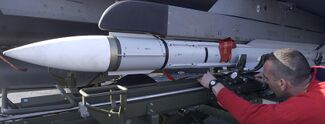M-13 MSRA
| M-13 MSRA | |
|---|---|
 A MSRA being fitted to the wing of an EF-161 Raven | |
| Type | Active radar guided air-to-air missile and surface-to-air missile |
| Place of origin | |
| Service history | |
| In service | 2008-Present |
| Used by | Acrea |
| Wars | Zemplen War |
| Production history | |
| Designer | NordEX Försvarssystemet AB |
| Manufacturer | NordEX Försvarssystemet AB |
| Specifications | |
| Weight | 160 kg (350 lb) |
| Length | 3.4 m (11 ft 2 in) |
| Diameter | 160 mm (6.3 in) |
| Effective firing range |
|
| Warhead | High explosive blast-fragmentation |
Detonation mechanism | Proximity or direct impact fuse |
| Engine | Throttleable ducted rocket |
| Speed | Mach 4+ |
Guidance system |
|
The M-13 MSRA, often called the "Misrah", is an active radar guided air-to-air missile and surface-to-air missile designed and manufactured by Kobalt-Zeiss AG and NordEX Försvarssystemet AB. The missile was designed to achieve the long range, multi-target capability of the previous M-10C DRAAM missiles, while utilising a smaller missile with very high kinematic performance. It was designed in tandem with the M-9 IRSS infrared missile to arm the EF-650 Striga and EF-662 Vampyr fighters, as well as to equip existing fighters with more capable armament. The missile has an operational range exceeding 100 km, or approximately 54 nm.
Design
Propulsion
The MSRA is often compared to the Ossorian DAAMR as it uses a throttleable air-augmented rocket to increase range. Substantial development funding and time went into delivering this capability in a compact system intended for increased capacity within the weapons bays of EFX-series fighters, as well as shaving off unnecessary weight from the missile. This included several variations on the design, including streamlined intakes built into the missile body at the root of the rear wings which open upon launch of the missile to reduce drag, as well as a more compact motor.
A significant feature of the MSRA is its use of thrust vectoring control. Adopted from development of the M-9 IRSS, thrust vectoring was added to better utilise the TWS guidance features that new AESA radars being designed into the EF-650 and EF-662, and which were being upgraded into the EF-135, were capable of. Focus went into ensuring that the MSRA was able to retain energy as it closed to the target, which in combination with the thrust vector control provides significantly improved performance against hard-maneuvering targets compared to other contemporary radar-guided missiles. The kinematic performance and energy preservation capabilities of the MSRA were a significant design focus.
Control
Being designed with the sensor fusion and data link capabilities of EFX-series fighters in mind, the MSRA was the first air-to-air missile in service to introduce extensive functionality via datalink in addition to its own inertial navigation system. The use of Acrean fleet-standard MSL data link allows the aircraft to receive mid-course updates to its flight path as well as be redirected to a new target while in flight (flight solutions permitting) by third-party aircraft in addition to the launching aircraft. Guidance of the missile can be actively "passed off" to other aircraft mid-flight using the datalink. Terminal guidance is provided by the missile's onboard AESA radar, and has a terminal stage range of approximately 11 nm.
Beginning in 2018, development began on the MSRA-EM, a next-generation update for the MSRA utilising a dual infrared/radar seeker head. Continued development of this missile has continued with the C-model body as a base.
Warhead
Variants
- M-13A MSRA - Initial production missile delivered beginning in 2006
- M-13B MSRA - Model with improvements to control surfaces, retrofitted to all missiles in late 2010
- M-13C MSRA - Model with improved onboard radar, inertial navigation system, and rocket motor adopted in 2016
- M-13C MSRA-EM - Model with dual radar/IR seeker head in testing